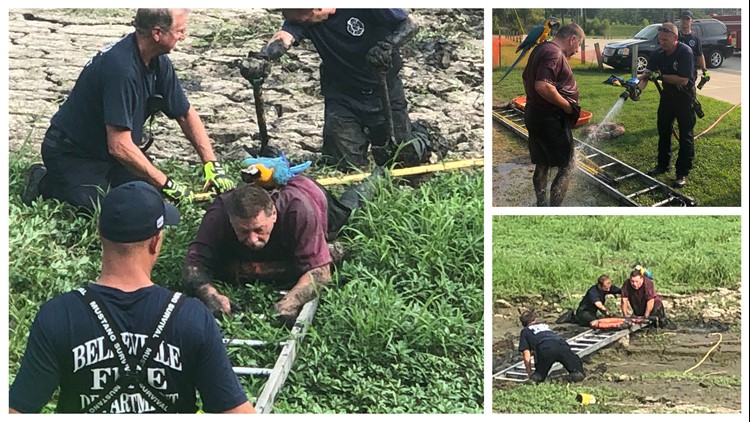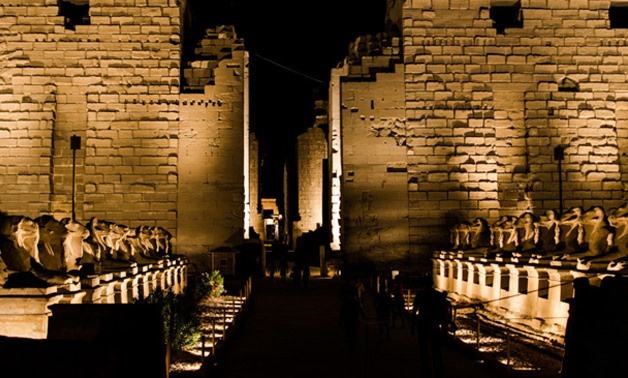Judi Lynn
Judi Lynn's JournalMan rescued from mud with parrot perched on his shoulders
Updated 1:50 pm CDT, Monday, August 13, 2018
BELLEVILLE, Ill. (AP) — Firefighters had to rescue a southwestern Illinois man from deep mud after he became stuck while trying to reach his pet parrot.
Belleville firefighters were called Sunday afternoon to the city's Bicentennial Park after a visitor heard the man calling for help.
Fire Chief Tom Pour tells the Belleville News-Democrat the mud from the lake being dredged was like quicksand.
The man was in mud up to his waist when crews arrived. Video shows that firefighters had to extend ladders across the mud to help him out — as the parrot remained perched on his shoulders.
More:
https://www.chron.com/news/us/article/Man-rescued-from-mud-with-parrot-perched-on-his-13152237.php

![]()
New Ancient Egyptian Sphinx Discovered in Luxor
MIRNA ABDULAAL
AUGUST 9, 2018
General Director of Luxor Antiquities Mohamed Abdel Aziz announced on Sunday that a second ancient Egyptian sphinx, dating back more than 4,000 years, was discovered during the development of Al-Kabbash Road project.
The latter is located between the ancient temples of Karnak and Luxor.
Abdel Aziz added that the statue will be lifted and extracted when the environment is more suitable, yet he urged tourists to visit the Al Kabbash road to take the first glimpse of the remarkable discovery.
The statue is described to have a “lion’s body with a human’s head”, which is different from the smaller statues that usually have a ram head.
More:
https://egyptianstreets.com/2018/08/09/new-ancient-egyptian-sphinx-discovered-in-luxor/
~ ~ ~
ANCIENT EGYPT: NEW SPHINX STATUE UNCOVERED IN HISTORIC LUXOR CITY
BY KATHERINE HIGNETT ON 8/10/18 AT 5:50 AM

File photo: Luxor's avenue of sphinxes is pictured.
GETTY IMAGES
Archaeologists have discovered a sphinx buried in Luxor in Egypt—the site of the ancient city of Thebes—Egypt Today has reported.
The newly uncovered sphinx is the latest treasure imparted by Luxor’s ancient Al-Kabbash Road, much of which is lined with the magnificent stone creatures.
Al-Kabbash Road links the famous Luxor Temple to Karnak Temple—two vast and impressive centers built for the ancient god Amon, who was particularly revered in Thebes from about 2000 BCE.
The statue is pretty small compared to the famous Great Sphinx of Giza, which sits near the Great Pyramids of Giza. But what it lacks in size, it makes up for in company. The avenue of sphinxes and the temples it connects were originally home to more than 1,000 of the ancient mythological statues, The Independent reported back in 2010.
More:
https://www.newsweek.com/ancient-egypt-new-sphinx-statue-uncovered-historic-luxor-city-1067209
~ ~ ~

Luxor's Al-Kabbash Road at night - Egypt Today/Sallie Pisch
New sphinx discovered in Luxor
By: Egypt Today staff Thu, Aug. 9, 2018
CAIRO – 9 August 2018: A sphinx was found during the development of Al-Kabbash Road project, declared General Director of Luxor Antiquities Mohamed Abdel Aziz on Sunday.
Abdel Aziz remarked that the ministry is currently working on lifting the statue because due to the nature of the environment it is in, it cannot be extracted directly from its place.
He added that Minister of Antiquities Khaled al-Anani has urged tourists to visit Al-Kabbash road to see the statue.
In the same context, Bassam al-Shamma, a researcher in Egyptology, remarked that the Sphinx’s discovery is expected as several sphinx statues are found across Luxor such as the sphinx statues for King Aymanhotb III and Thutmose IV.
More:
http://www.egypttoday.com/Article/4/55645/New-sphinx-discovered-in-Luxor
Tropical forest canopies get hotter than expected, putting wildlife at risk
by Morgan Erickson-Davis on 3 August 2018
. . .
New research finds that the canopies of tropical forests get significantly hotter than the surrounding air. As global warming ups temperature extremes around the world, scientists worry that this means the treetops of rainforests and the wildlife that live in them could fare poorly in the future. They found high temperatures could also diminish tropical forests’ abilities to remove greenhouse gases from the air, reducing their effectiveness as carbon sinks at a time when the world needs them the most.
To better understand how the temperatures at the tops of trees in a rainforest compare to surrounding air temperatures and how this might affect the functioning of the trees themselves, researchers at Florida State University in the U.S. trained thermal cameras on a tract of rainforest in Barro Colorado Island in Panama.
A study published recently in Ecosphere reveals that the canopies they looked at exceeded the maximum air temperature by as much as 7 degrees Celsius. For context, the Paris Agreement is attempting to stave off the worse effects of climate change by keeping warming under 2 degrees Celsius.

Changing temperatures in the forest canopies of Panama’s Barro Colorado Island could mean major consequences for overall forest health. Photo by Stephanie Pau
Overall, they found that canopies could become 40 percent warmer than the surrounding air. The researchers write that this could have dire implications not only for the trees themselves, but also for the plants and animals that spend their lives in their treetops.
More:
https://news.mongabay.com/2018/08/tropical-forest-canopies-get-hotter-than-expected-putting-wildlife-at-risk/
12-year-old 'genius' enters Mexican university
4 August 2018 — 8:27am
Mexico City: The youngest student ever admitted to Mexico's National Autonomous University wouldn't call himself a "genius."
Carlos Santamaria Diaz, a 12-year-old who will begin classes for an undergraduate degree in biomedical physics on Monday, was dwarfed by the upholstered blue chair he sat in to answer reporters' questions on Friday.
With his feet barely brushing the floor, he laughed out loud and shook his head when a reporter asked if he considered himself a genius.
. . .
The boy from western Guadalajara grew bored with public school at an early age and turned to the web where he taught himself calculus and physics. By the age of nine, he participated in university programs in analytical chemistry, biochemistry and biology.
More:
https://www.smh.com.au/world/north-america/12-year-old-genius-enters-mexican-university-20180804-p4zvhi.html
70 years ago, a Navajo veteran helped earn Native Americans the right to vote in New Mexico
By ANDREW OXFORD | The Santa Fe New Mexican | Published: August 3, 2018
SANTA FE, N.M. (Tribune News Service) — Miguel Trujillo Sr. had been a Marine sergeant in World War II and was in the middle of getting his master’s degree from the University of New Mexico.
But there was one thing he still couldn’t do.
Trujillo couldn’t vote.
In 1948, the state’s constitution barred American Indians living on reservations from participating in elections.
More:
https://www.stripes.com/news/70-years-ago-a-navajo-veteran-helped-earn-native-americans-the-right-to-vote-in-new-mexico-1.540901
~ ~ ~
Fighting for the Right to Vote
NOVEMBER 7, 2016
. . .

USMC Miguel Trujillo of Isleta Pueblo
with his daughter Josephine T. Waconda
in the late 1940s.
More:
https://www.indianpueblo.org/fighting-right-vote/
. . .
A History of Indian Voting Rights and Why It’s Important to Vote
https://newsmaven.io/indiancountrytoday/archive/a-history-of-indian-voting-rights-and-why-it-s-important-to-vote-IQ2lTgiylkiC9GQ98IvhWA/
Day of the Journalist: Colombia's journalists need more protection
August 3, 2018
As Colombia prepares to mark “Day of the Journalist” tomorrow, Reporters Without Borders (RSF) deplores the increasingly dangerous environment for media personnel in this Caribbean and Andean country, where the past month has seen a disturbing surge in threats and two journalists were murdered yesterday.
Yesterday’s victims, local newspaper editor Jairo Alberto Calderón Plazas and local radio host Valentín Rúa Tezada, were slain in separate shooting attacks in the western Cauca Valley.
The threats and deadly violence have come at a time of marked political polarization during the transition from outgoing President Juan Manuel Santos to President-elect Iván Duque, who will take office on 7 August. There has been a surge in attacks and intimidation attempts by the paramilitary armed groups still present in many parts of Colombia, which have stepped up their harassment of human rights defenders, union leaders and journalists regarded as problematic.
Jineth Bedoya, a well-known journalist who is deputy editor of the daily El Tiempo, and journalists with La Silla Vacía, a news website,were among those on a hit-list signed by a far-right paramilitary group called the Bloque Central de Las Águilas Negras that was circulated on 14 July.
More:
https://rsf.org/en/news/day-journalist-colombias-journalists-need-more-protection
AP PHOTOS: A glimpse into life in Cuba's 2 Guantanamos
Ramon Espinosa, Associated Press
Updated 9:54 am CDT, Friday, August 3, 2018
GUANTANAMO, Cuba (AP) — While Muslims detained at the U.S. naval station base at Guantanamo Bay bowed their heads in prayer on a recent day, Cuban men in the nearby city of Guantanamo tooted horns and banged on drums as they prepared for a carnival.
The two Guantanamos have been a contrast since the U.S. opened the base at the southeastern tip of the island in 1903, following the Spanish-American War, and the divide has only grown under Cuba's communist government, which refuses to cash the annual rent checks from Washington as it insists the U.S. leave.
People on both sides of the closely monitored boundary have long led different lives, yet they all live under government restrictions and appeals to patriotism.
They are separated by a "cactus curtain" planted by Cuban soldiers in the early 1960s following the revolution led by Fidel Castro, to deter Cubans from trying to find refuge at the base. Some land mines are also believed to remain on Cuban soil, while the troops on the U.S. side rely on sound and motion sensors.
More:
https://www.chron.com/news/world/article/AP-PHOTOS-A-glimpse-into-life-in-Cuba-s-2-13128499.php#photo-15959562
Profile Information
Member since: 2002Number of posts: 160,630